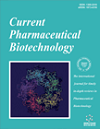- Home
- A-Z Publications
- Current Pharmaceutical Biotechnology
- Previous Issues
- Volume 14, Issue 15, 2013
Current Pharmaceutical Biotechnology - Volume 14, Issue 15, 2013
Volume 14, Issue 15, 2013
-
-
Editorial (Thematic Issue: “Nanosize Drug Delivery System”)
More LessNanosize materials provide hopes, speculations and chances for an unprecedented change in drug delivery in near future. Nanotechnology is an emerging field to produce nanomaterials for drug delivery that can offer a new tool, opportunities and scope to provide more focused and fine-tuned treatment of diseases at a molecular level, enhancing the therapeutic potential of drugs so that they become less toxic and more Read More
-
-
-
The Use of Micro- and Nanoparticles in the Stabilisation of Pickering-Type Emulsions for Topical Delivery
More LessAuthors: Marie Wahlgren, Johan Engblom, Malin Sjoo and Marilyn RaynerThis review describes the use of Pickering emulsions for topical drug delivery. The focus is on Pickering emulsions and how to formulate these. However, a short description of the challenges of topical drug delivery is also given. The article describes how Pickering emulsions might have other properties than traditional topical creams. It is our believe that Pickering emulsions could give added value to topical formulations as it is Read More
-
-
-
Preparation and in vitro Evaluation of α and β -Amyrins Loaded Nanoemulsions
More LessThe triterpenes α- and β-amyrins display important pharmacological activities. As a result of their high hydrophobia, they present low water solubility and reflect poor oral bioavailability. Different techniques can be used for the improvement of amyrins solubility, one of them is the use of nanoemulsions. Therefore, the method of direct emulsification was used to develop a nanoemulsion of these triterpenes and the resulti Read More
-
-
-
Nanoparticles for Triggering and Regulation of Immune Response of Vaccines: Perspective and Prospective
More LessAuthors: Sivakumar S. Moni, Mohammed M. Safhi and Bhakti B. BarikNanoparticles mediated vaccine delivery is an emerging technology and considered as better adjuvant for delivering vaccines when compared to conventional delivery system. The purpose of this delivery system is to provide simple stable formulation that elicits lifelong immunity preferably with single shot. In line to develop the biodegradable polymer vaccine delivery system it is necessary to understand about the nature of Read More
-
-
-
Potentials and Challenges of Active Targeting at the Tumor Cells by Engineered Polymeric Nanoparticles
More LessAuthors: Biswajit Mukherjee, Bhabani S. Satapathy, Laboni Mondal, Niladri S. Dey and Ruma MajiTumor targeted therapy has brought a new hope to the cancer patients. With the recent advances in nanotechnology and growing knowledge on unique cancer biomarkers, it is now possible to manipulate the surface architecture of polymeric nanoscale delivery systems with targeting moieties, such as antibodies, antibody fragments, specific molecules, small peptides, RNA aptamers etc. to target specific receptors and Read More
-
-
-
Nanobiotechnology-based Drug Delivery in Brain Targeting
More LessAuthors: Subas C. Dinda and Gurudutta PattnaikBlood brain barrier (BBB) found to act as rate limiting factor in drug delivery to brain in combating the central nervous system (CNS) disorders. Such limiting physiological factors include the reticuloendothelial system and protein opsonization, which present across BBB, play major role in reducing the passage of drug. Several approaches employed to improve the drug delivery across the BBB. Nanoparticles (NP) are the so Read More
-
-
-
Inhibitors of Bacterial Transcription are Compounds for Potent Antimicrobial Drugs
More LessAuthors: Katarzyna Turecka and Krzysztof WaleronThe increasing resistance of microorganisms against antibiotics available on the pharmaceutical market is now a global problem. There is an incessant necessity to search for new, effective treatments against resistant strains of microorganisms, for new potent classes of antibiotics with novel modes of action targeted at important components of microbial cells. Such a critical, essential system for cell functioning is a RNA Read More
-
-
-
Enhancement of the Pharmacological Efficacy of FGF-21 by Genetic Modification and PEGylation
More LessAuthors: Xianlong Ye, Jianying Qi, Guopeng Sun, Guiping Ren, Shenglong Zhu, Yunzhou Wu, Dan Yu, Jingzhuang Zhao, Mingyao Liu and Deshan LiFGF-21 is a potential candidate for the treatment of type 2 diabetes mellitus. However, the clinical application of wild-type human FGF-21 is challenging due to some limitations, such as its poor hypoglycemic potency and short in vivo half-life. In this paper, we have produced an FGF-21 mutant (ahmFGF-21) by exchanging the functional domain of hFGF-21 with that of mFGF-21 to improve the potency of FGF-21. Results s Read More
-
Volumes & issues
-
Volume 26 (2025)
-
Volume 25 (2024)
-
Volume 24 (2023)
-
Volume 23 (2022)
-
Volume 22 (2021)
-
Volume 21 (2020)
-
Volume 20 (2019)
-
Volume 19 (2018)
-
Volume 18 (2017)
-
Volume 17 (2016)
-
Volume 16 (2015)
-
Volume 15 (2014)
-
Volume 14 (2013)
-
Volume 13 (2012)
-
Volume 12 (2011)
-
Volume 11 (2010)
-
Volume 10 (2009)
-
Volume 9 (2008)
-
Volume 8 (2007)
-
Volume 7 (2006)
-
Volume 6 (2005)
-
Volume 5 (2004)
-
Volume 4 (2003)
-
Volume 3 (2002)
-
Volume 2 (2001)
-
Volume 1 (2000)
Most Read This Month
Article
content/journals/cpb
Journal
10
5
false
en


